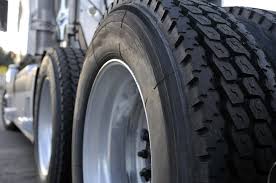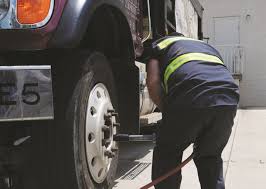Fleet Truck Tire Maintenance Tips You Cannot Afford To Ignore
Let’s face it. Fleet truck drivers, on the whole, are not terribly concerned with the proper maintenance of truck tires that are taking them from Point A to Point B. Especially now, with mandatory electronic logs that are keeping them accountable when on duty, they’re less likely than ever to lose driving time to perform an “unpaid” task on their own, like ensuring their tires are functioning safely and optimally at all times.
For example, drivers are often re-inflating tires that have run 20% or more in an under-inflated condition. And this is a problem, even with those drivers that do check inflation pressure regularly, because they may not be aware of the potential dangers of personal injuries or blowouts on the road when a tire in low-pressure condition is simply topped up and considered to be road-worthy again.
Commercial/Vocational truck safety is a constant concern with fleet owners, and being vigilant about tire safety is a primary concern that both drivers and their supervisors should be making a priority. Below, we have listed 6 tips that will keep tire performance high, extend tire life, and keep vehicles and drivers safe on the road:
# 1: ALWAYS BE ON `GATOR’ ALERT
Gators are pieces of tire left on the road when a retread tire shreds. The textured lengths of broken-off rubber, with ridges and scales, look like the back of alligators, and hence their name. Road Gators are most often encountered on interstates where the speed limit is 70 mph-75 mph.
The reason Road Gators pose a danger to truck drivers is this: they can potentially rip steering components, damage oil pans or even smash through the windshield. Being watchful of them, especially during low-light conditions, is necessary when you’re driving cargo-laden or any other kind of vocational trucks for long hours at a stretch.
# 2: RECAP AS SOON AS THE TREADS ARE WORN
Treads are the part of the tire that maintains traction with the road, and any signs of wear and tear should be addressed as soon as possible. The Penny Test (inserting a penny into a groove on the tread, head pointing down, and knowing the tread is too worn when the top of Lincoln’s head become visible) is a good way to check on this.
Thick-bodied, quality tires can be retreaded to give them a new lease of life, and the process — called “recapping” – is a smart way to make expensive tires work longer for you.
# 3: AFTER EVERY 5,000 MILES, IT IS TIME TO ROTATE
Tires don’t wear out equally because vehicles aren’t perfectly balanced quadrilaterally. Rotation is the solution, because when you shuffle tires around, they are more likely to sustain a similar amount of wear and tear and finally need replacement at the same time.
The standard schedule for rotation is usually between 5,000 miles and 8,000 miles, but the manufacturer’s manual will give you the precise, recommended date. Maintaining a system where tires are rotated as per brand instructions for every truck in your fleet will pay off in the long run, because tires are a big financial investment.
# 4: “MIXING” TIRES IS NOT RECOMMENDED
Don’t mix tires on your fleet trucks. In other words, avoid pairing a normal tread depth with a deeper one, or a radial with a bias-ply tire.
# 5: PAY ATTENTION TO TIRE STORAGE
Tires can age pre-maturely if they are not stored in a cool, dry place that is sheltered from direct sunlight, and this can significantly reduce their working life. Washing tires regularly is another way to hold off pre-mature aging.
# 6: EVERY TRIP MERITS AN INSPECTION
Before a rig goes out, or after it comes in, it is important to inspect the tires for damages sustained from potholes, uneven road surfaces, glass shards, rocks and all kinds of other debris that litter the roadways. Drivers are not always aware that their tires have been compromised, especially during low-light hours, and they run the risk of a blow-out, costing the fleet company time and money, when a simple inspection at the end of a trip can easily locate and rectify these problems.

Tires for lifted trucks
Lifted trucks have the best off-road results when you pair them with the right tires. Higher trucks with bigger tires allow you to ride harder, faster and better over mud, rocks, sand or snow. When you lift a truck, you also need to buy tires that support your vehicle’s new height and size.
When shopping for tires that support your chosen lift kit option, it’s best to evaluate what you want out of your vehicle — for both style and performance! Determining the type of tire needed to accommodate your driving lifestyle will inform the clearance room required for your wheels which ultimately decides the height of the lift installed on your truck or SUV.
A stronger, wider, larger tire is always your best option, no matter if you choose to install a leveling kit, body lift kit or a suspension lift kit. Most lift kit manufacturers provide suggested tire sizes for each of their kits. It is also very helpful to visit internet forum pages to gauge the experience and advice of other vehicle owners who have lifted their truck or SUV. Depending on your vehicle’s make/model and size of the lift, you can fit anywhere from 33-inch tires, 35-inch tires or even 37-inch tires.

How Lifting Your Truck Changes Tire Wear Patterns
When you lift a truck, you generally add bigger tires, which are heavier and wear down more quickly when driven on asphalt. Most tires for lifted trucks are for off-roading, which means they have aggressive treads that wear down quickly on hard surfaces. Ideally, having two sets of tires—one for off-roading and one for everyday driving—would be the best option, but that involves buying and storing two full sets of wheels. It’s also in super inconvenient if you don’t have your own tools to switch between sets when you need to. A more wallet-friendly option to cut down on tire wear is to switch out your steel or alloy rims for a set of forged one-piece wheels. They are lighter and stronger, but are still pretty expensive, so they aren’t for everyone.

Truck tire replacement frequency
Every truck is different. This means that, unlike passenger cars, there’s no solid guide that lists the recommended tire replacement intervals for all semi trucks or work trucks. In Florida, a driver can usually expect to get up to 100,000 miles from a semi truck tire set. Without a standardized guide, though, the most important thing you can do is stay up to date with truck and tire maintenance.
TIRE MAINTENANCE TIPS
Here are a few ways you can keep your truck’s tires in good condition for longer:
- Check for Proper Inflation: After you’ve given the tires time to cool, check the tire pressure. To check for the correct PSI, weigh the truck fully loaded. Make sure you weigh the front, rear, and trailer axles separately. You can find the right PSI by comparing the axle weights to those listed in the tire manufacturer’s book. Pay special attention to the load supported by the front axle. If the scale weight exceeds the maximum load-carrying capacity, you’ll need to upgrade to higher capacity tires.
- Keep Tabs on Tire Wear: Tire wear is caused by friction. To make sure your truck’s tires are wearing evenly, you’ll need to keep up with tire alignments and pay close attention to inflation and load-carrying capacities. Putting tire service off will have consequences — the severity of which depends on the length of time tire maintenance is ignored.
- Inspect Your Tires Regularly: Your truck components, especially the tires, require routine inspections. Mainly, you’ll want to check for signs of wear and tear and proper inflation. If your truck’s tires are 20% below their recommended PSI, they’re technically flat tires and should be replaced immediately. You’ll also want to double-check the condition of the valve caps, tire
How to choose the right truck tires
Here are two points to keep in mind while you’re shopping for tires:
- Load Capacity: If you drive a larger truck, such as an HV Series or MV Series, your tires will be under a serious amount of strain. For this reason, it’s important to choose tires that can handle high load capacities and demanding conditions. This is crucial to job performance, as well as safety. Before you buy a tire, check its load index. This information is written out as a numerical code that states the load capacity of that tire at the speed indicated by its speed symbol.
- Off-Road Driving: Different types of driving require different types of tires. For example, commercial tires designed for travel through Miami don’t have tread strong enough to traverse rough surfaces like rock or gravel on a daily basis. Even if your job only takes you off paved roads occasionally, opt for tires that are 80% on-road and 20% off-road.
LT Tires for Heavy Loads, Towing and Off-Road Durability
LT tires are going to be more expensive than p-metric tires. This is because LT tires have extra material in the sidewall and under the tread that protects the tire from damage. The cords in a LT tire are a larger gauge than P-metric tires so the tire can carry heavier loads. Very often LT tires will have an extra steel belt, a deeper tread and thicker rubber in the sidewall for more protection vs a p-metric tire. LT tires are usually 8-ply (Load Range D) or 10-ply (Load Range E). Passenger Tires usually have a 4-ply or 6-ply equivalent sidewall. The performance trade-off of this added weight is a harsher ride, less fuel efficiency, and less responsive handling.
Tread-wear or tire mileage is typically about the same for LT and P-metric tires, except if used often on gravel roads. If used on gravel roads, you should consider an LT tire instead of p-metric because the tread rubber in LT tires is usually especially formulated to resist chipping from stones. On paved highways, p-metric tires typically have better wet and dry traction on pavement.
If you drive your truck heavily loaded or pull heavy trailer loads frequently, you should consider replacing your p-metric tire with an LT tire. Tradespeople that have their truck or van loaded with tools, supplies and equipment often find that the stiffer LT tires provides less sway, and therefore more confidence inspiring handling as well. Others may find that the ride is slightly harsher and not as comfortable. This is one of the trade-offs you can expect when you replace a p-metric tire with a LT tire.